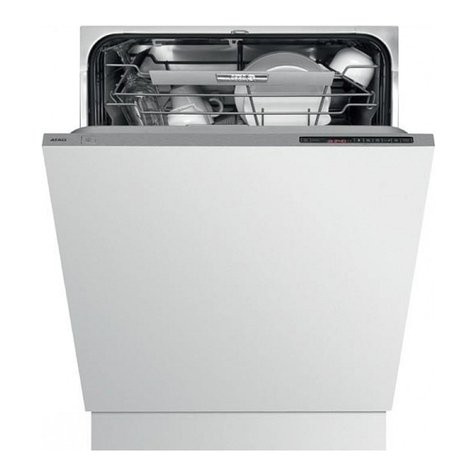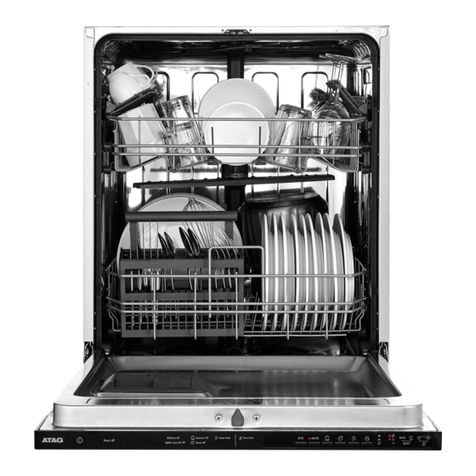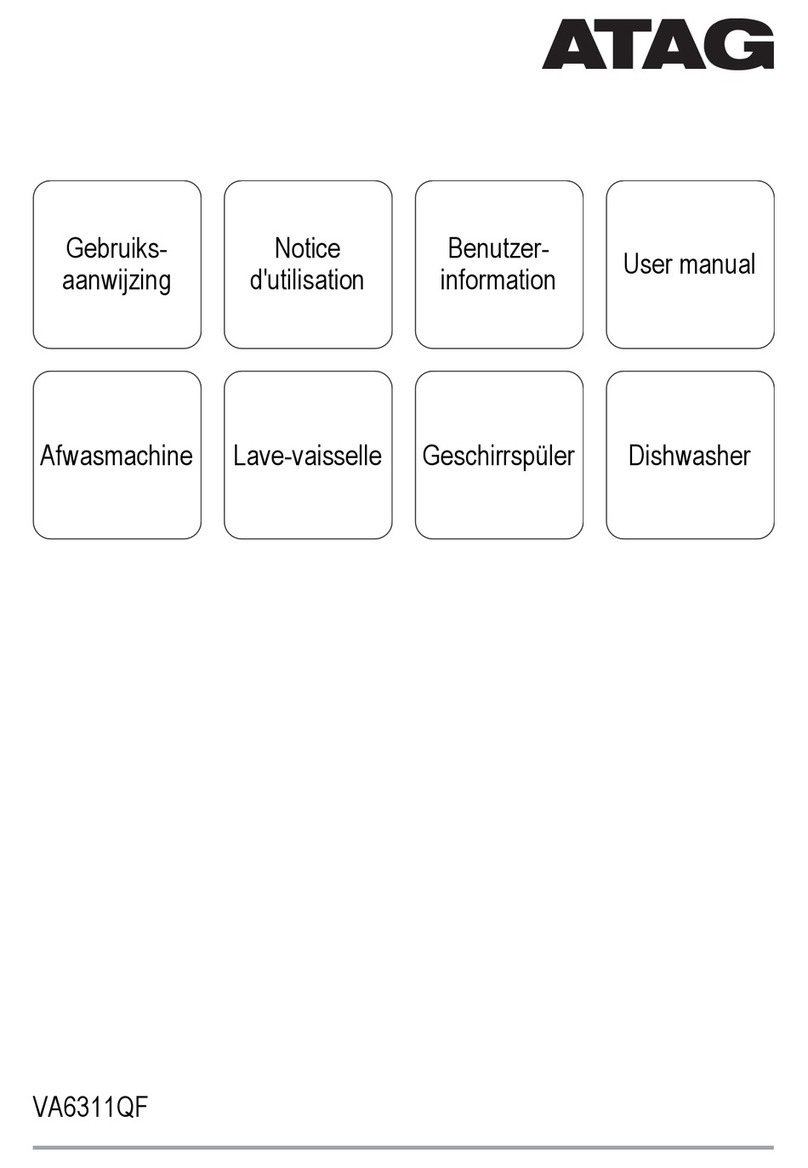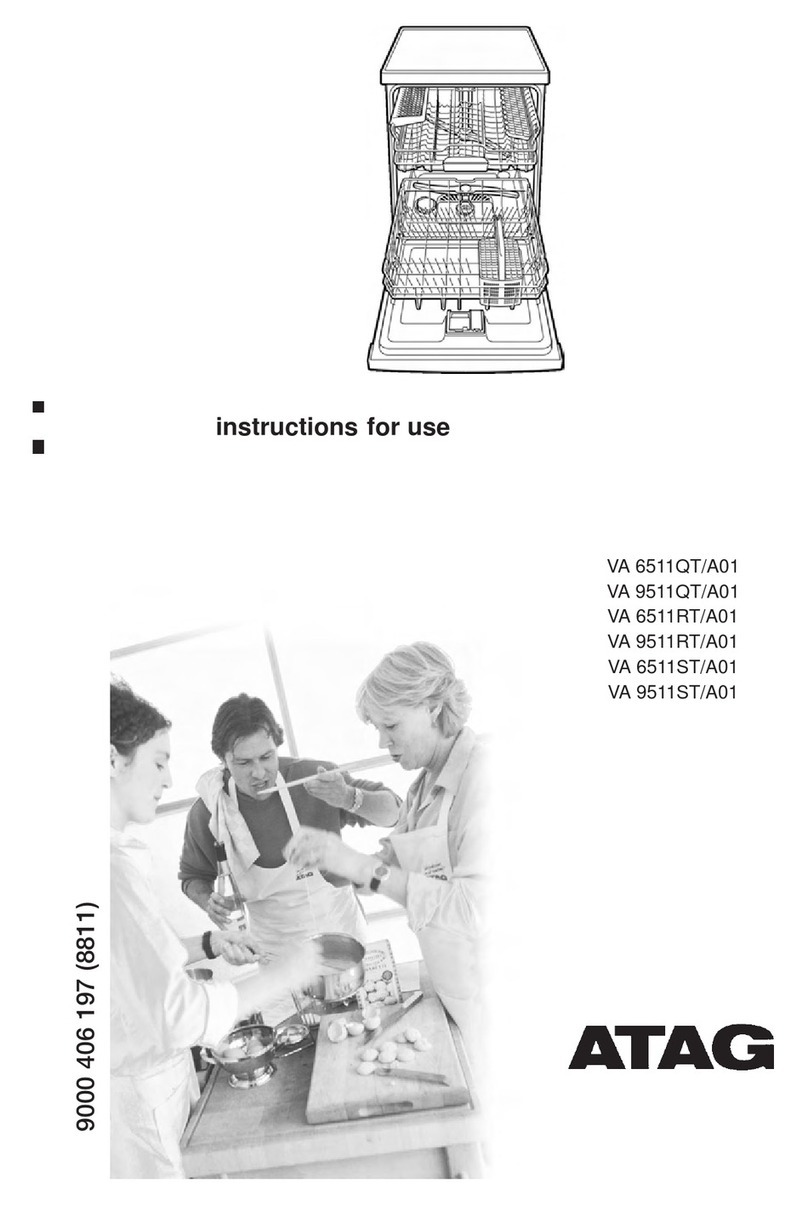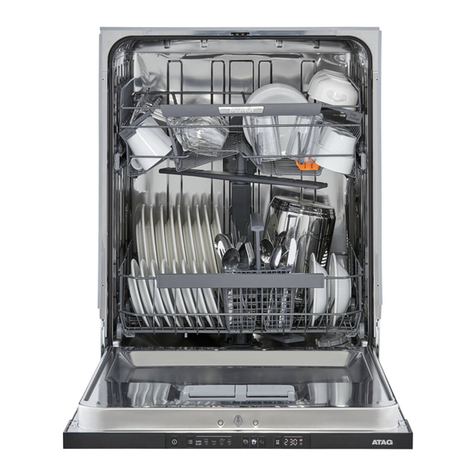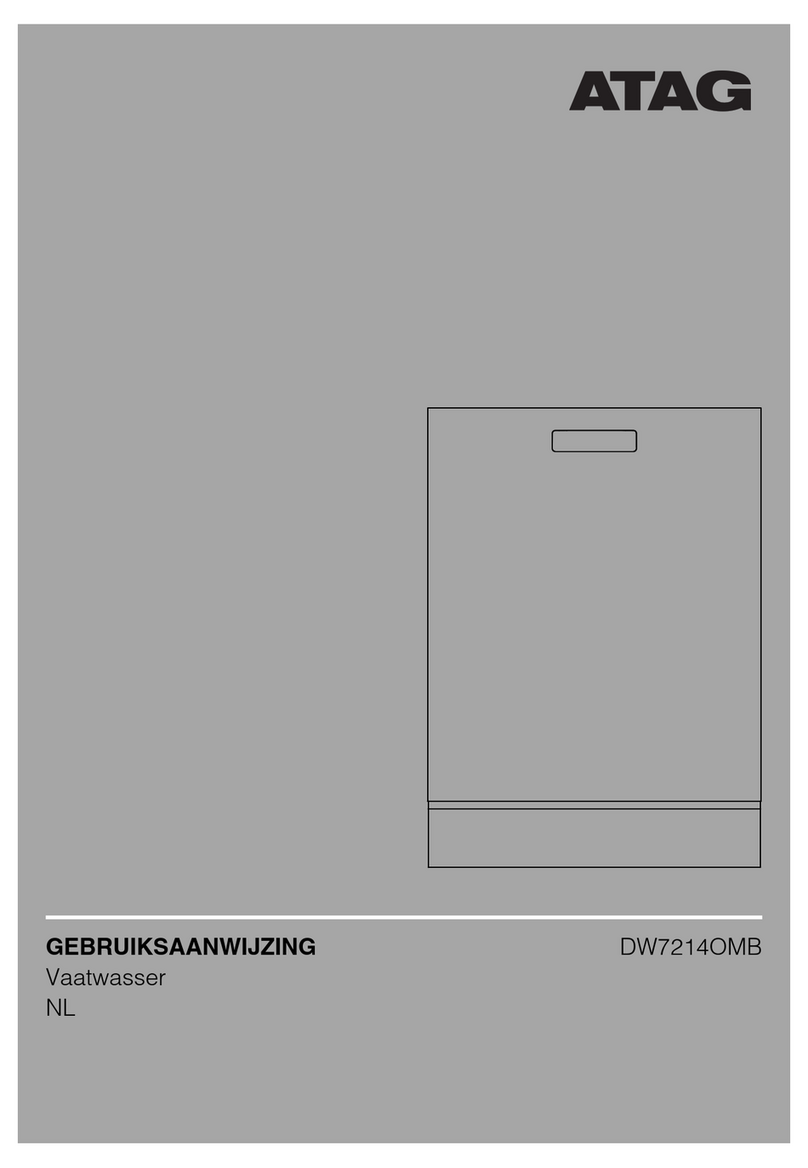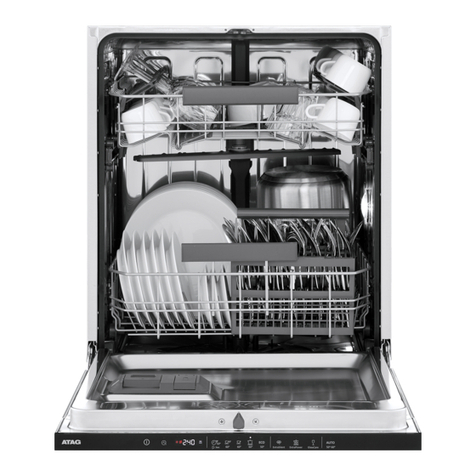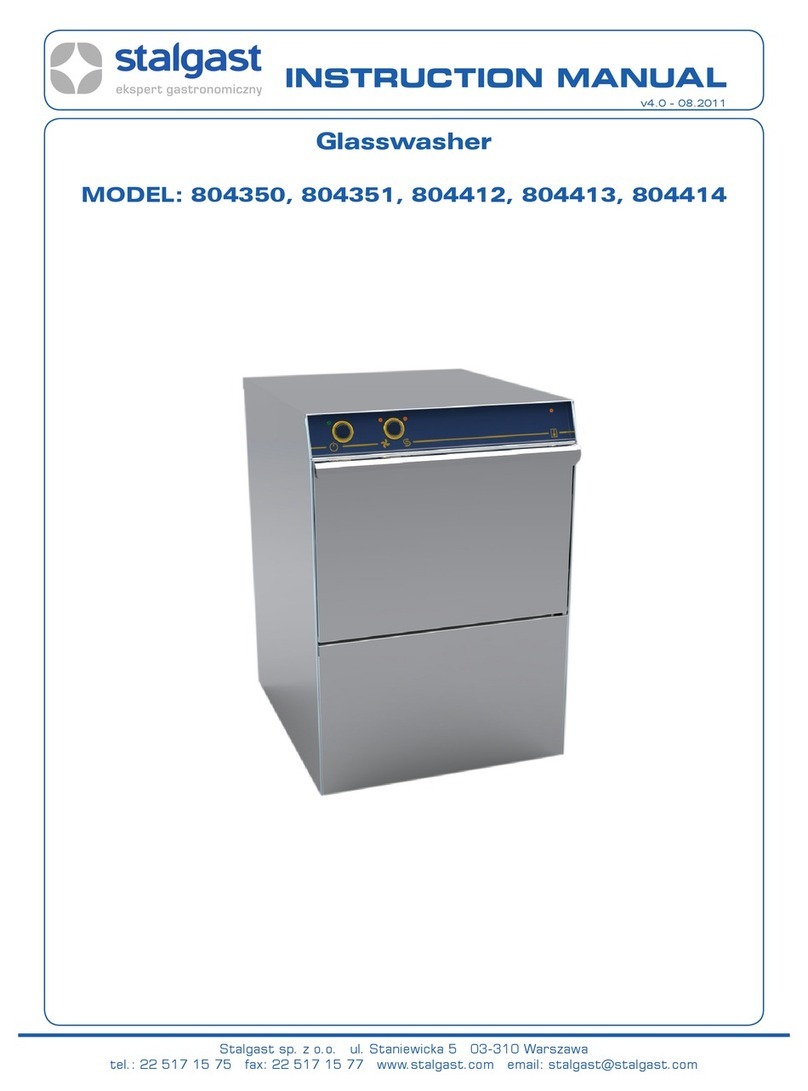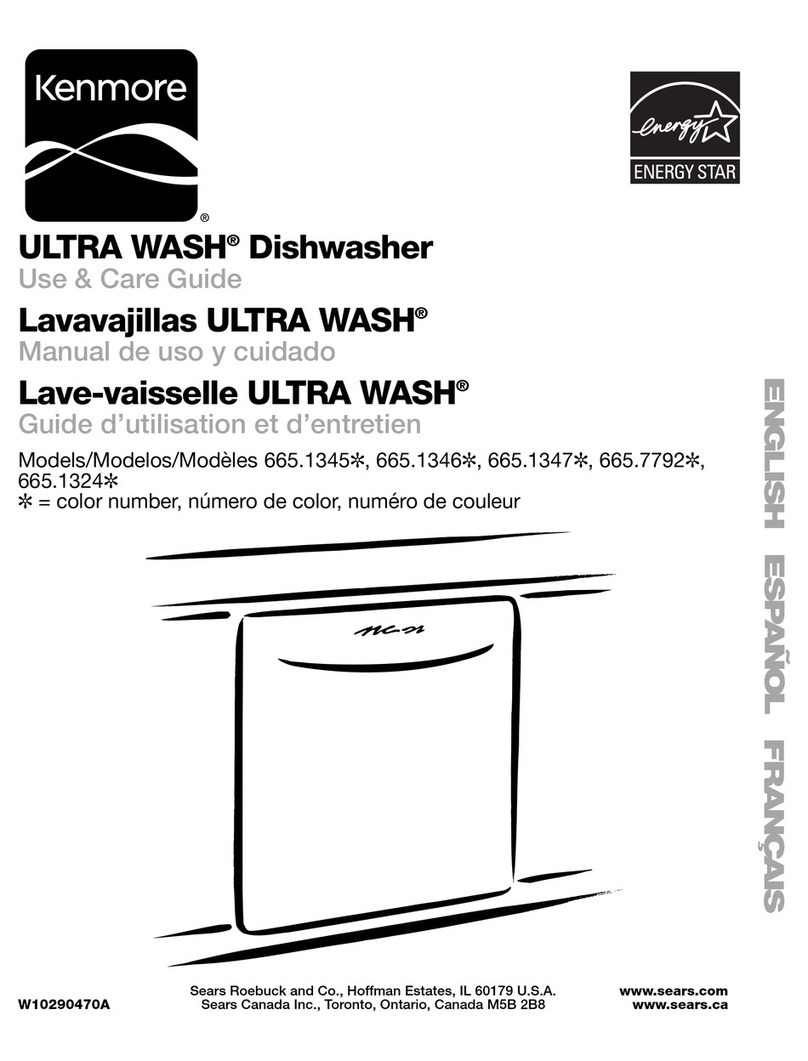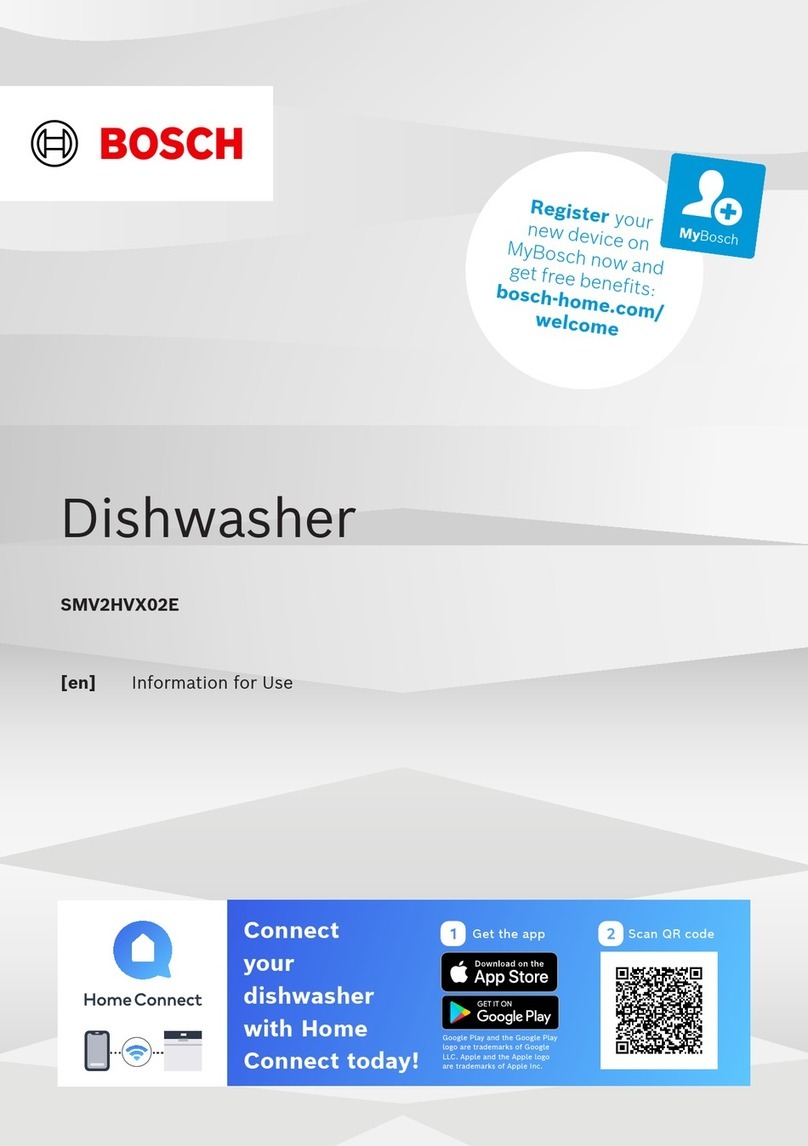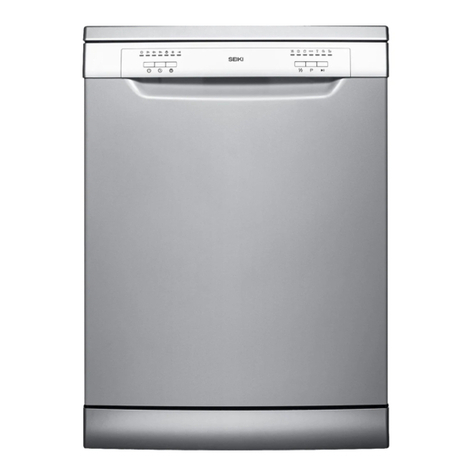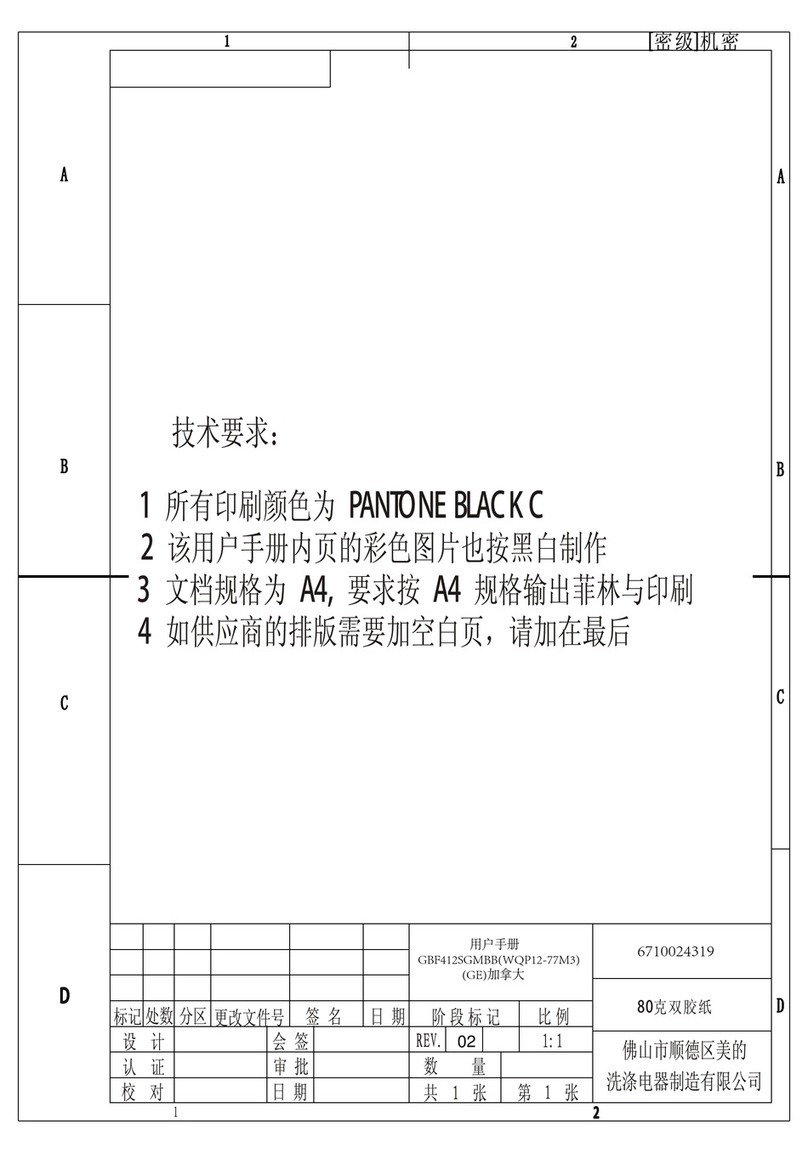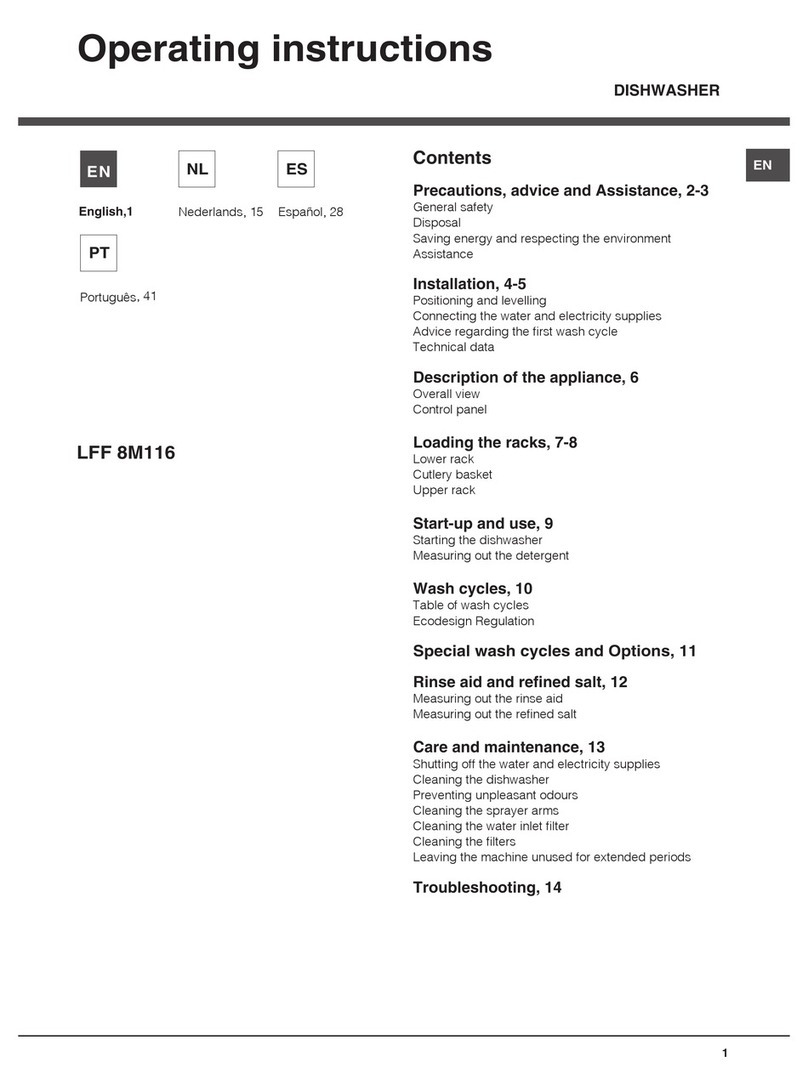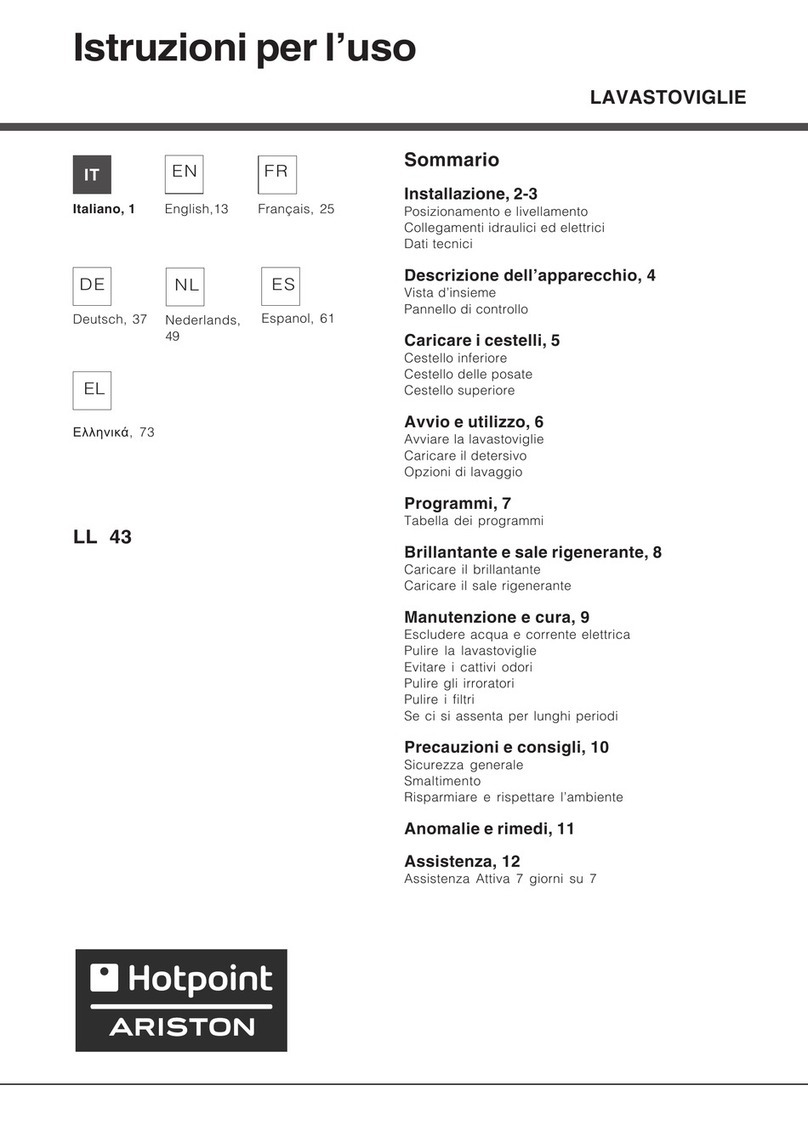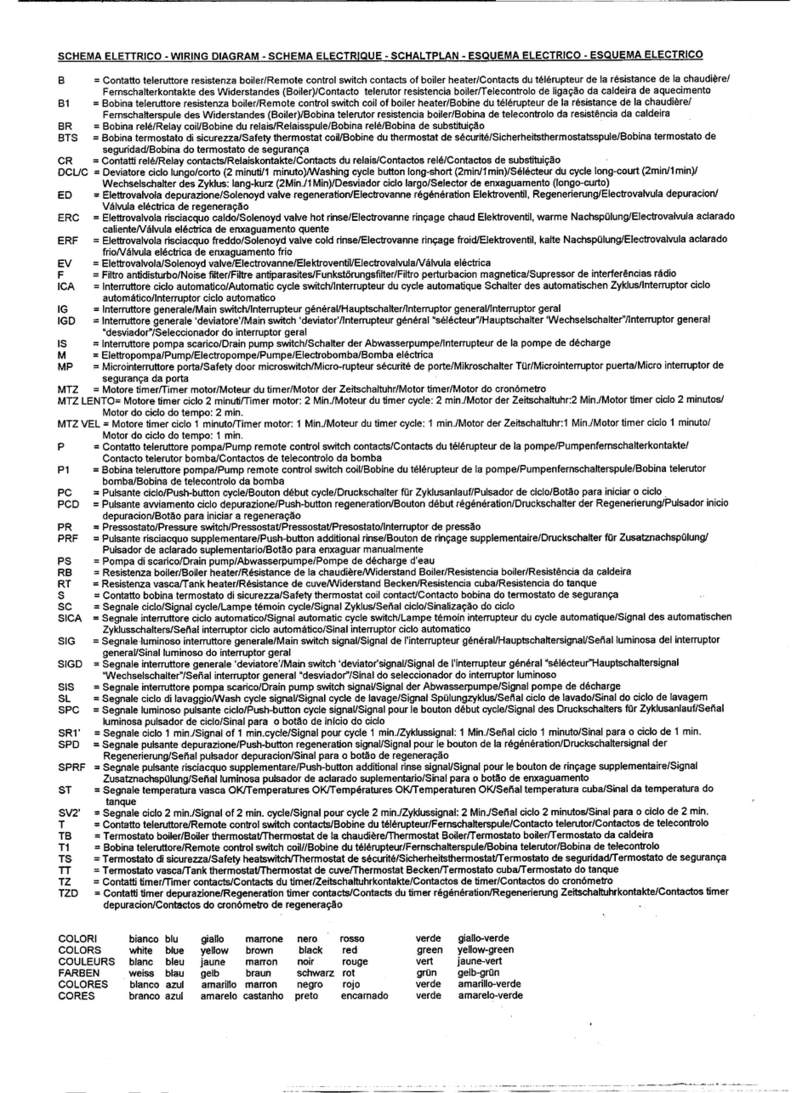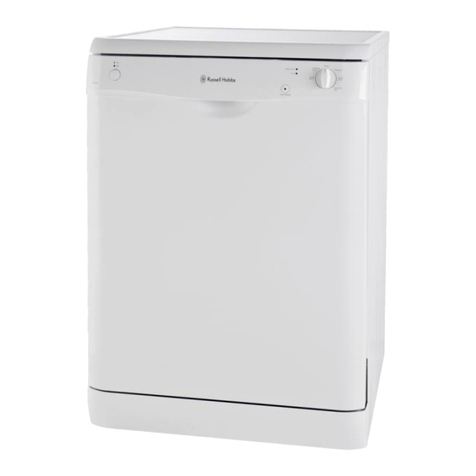Atag VA6611NT User manual

Use & Care Guide
Dishwasher
ATAG VA6611NT

2

3
Contents
Before doing your rst wash 4
Safety 5
Child safety 6
Parts of the dishwasher 7
Technical information 7
Baskets 8
Control panel 11
Dispenser 11
Basic Course 12
Programs 13
Options 14
Eco-dishwashing 16
Fragile dishes 17
Salt 18
Program description 19
Cleaning 20
Rinse aid 23
Settings 24
Fault indications 27
Troubleshooting 28
Performance information 31
Installation instructions 32
Service & guarantee 34
Own comments 35
Quick Guide 36

4
Before doing your rst wash
Read the directions of use
Read the directions of use before starting to
use your machine, especially the Safety, Child
Safety and Basic Course sections.
Take care with certain materials
Read the section ‘Fragile dishes’ before wash-
ing china with unglazed decoration or other
household goods made of plastic, wood or crys-
tal requiring careful treatment.

5
Safety
General
• Read and keep the directions for use!
• Installation of water, drainage and electricity
must be carried out by a qualied professional.
• Do not use the dishwasher for any purposes
other than those stated in this User Guide.
• Do not load the dishwasher with anything other
than dishes.
• Only use dishwasher detergent!
• Place knives and other sharp objects so that
they cannot cause injury to people or damage
the dishwasher.
• The appliance is not intended for use by per-
sons (including children) with reduced physi-
cal, sensory or mental capabilities, or lack of
experience and knowledge, unless they have
been given supervision or instruction concern-
ing use of the appliance by a person respon-
sible for their safety.
• Children should be supervised to ensure that
they do not play with the appliance.
• Damaged mains cables must only be replaced
by a qualied electrician.
• This appliance is intended to be used in
household and similar applications such as:
- sta kitchen areas in shops, oces and other
working environments
- farm houses
- by clients in hotels, motels and other residential
type environments
- bed and breakfast type environments
Never put dishes containing solvent residue in
the machine due to risk of explosion. Neither
may dishes containing ashes, wax or lubricating
grease be washed in the dishwasher.
Winter storage/Transport
Store the machine away from frost.
Avoid long journeys in extreme cold. Transport
the machine in an upright position or lying on its
back.
Overll protection
The overll protector starts pumping out water
and closes o the water intake if the machine’s
water level exceeds the normal level. If the over-
ll protector starts up, shut o the water supply
and phone for service. See ‘Troubleshooting’.
Cleaning
Only use a slightly damp cloth for cleaning
around the edge of the door. Do not use a spray
bottle! Water can penetrate into the lock and
come into contact with the electrical compo-
nents.
Packaging materials
Sort at source in accordance with the re-
commendations of your local authority.
Scrapping
When the time comes for the machine to be
scrapped, it should immediately be rendered
unusable. Remove the plug and cut o the lead
as short as possible.
Contact your refuse collection department or
your local authority for information on the correct
way to dispose of the machine!
The machine is manufactured and labelled for
recycling.

6
Child Safety!
Child-safe button lock
To prevent children starting the machine, you
can activate a button lock.
Proceed as follows:
1. Switch o the dishwasher with the main
switch.
2. Hold in the Temperature and Drying buttons
for 3 seconds, and at the same time switch
on the main switch.
The Temperature, Drying and start symbols will
then ash. Release the Temperature and
Drying buttons.
4. Press the Program selection button. Once
the symbol for Daily lights up, the button lock
has been activated.
5. Press the Start/Stop button to store the set-
ting.
Once the button lock has been activated, the
Temperature and Drying symbols will ash when
any of the buttons are pressed.
To deactivate the button lock temporarily when
you want to start the machine, press the Tem-
perature and Dry buttons simultaneously. The
button lock will then automatically switch on
again after 3 minutes.
To deactivate the button lock altogether, use
the same procedure as for activation. When the
symbol for Daily goes out, the button lock has
been deactivated.
Advice!
You can read more about this in the Settings
chapter.
Child-safe dishwashing
• Use the knife basket, or knife holder, for all
long/sharp items.
• Always close the door and start the program
immediately once dishwasher detergent has
been added.
• Keep children away from the dishwasher when
it is open. There might be remains of dish-
washer detergent present!
• Do not allow children to use or play with the
dishwasher. Always take particular care when
the door is open.
Protect your children!
- Dishwasher detergent is corrosive!
Store dishwasher detergent and rinse aid out
of the reach of children! Should dishwasher
detergent be swallowed, immediately drink one
or two glasses of milk or water. Do not attempt
to induce vomiting. Contact a doctor! Should
dishwasher detergent come into contact with the
eyes, rinse (for at least 15 minutes) with copious
amounts of water.

7
Parts of the dishwasher*
Technical information
Height
Width
Depth
Weight
Capacity*
Water pressure
Connection
Max
Accessories
*In accordance with standard, EN50242
**See type plate.
***The weight can vary due to varying specica-
tions.
820-870 mm
596 mm
550 mm
48/51 kg***
12 place settings
0.03-1.0 MPa (0.3–10 kp/cm2)
1-phase, 230 V, 50Hz 10/10A**
1600 W**
1. Upper basket
2. Spray arms
3. Cutlery basket
4. Lower basket
5. Rinse aid dispenser
6. Dishwasher detergent compartment
7. Main switch
8. Program panel
9. Filter
10. Type plate
* Details may dier
depending on model and market!
2
3
4
5
6
7
8
1
9
10

8
Baskets*
*Details may dier depending on the
model and market!
Upper basket
Lower basket

9
Cutlery basket
1a 1b 1c
2b
2a
2c
Cutlery basket with cover
*Details may dier depending on the
model and market!
Baskets*

10
Placement of the cutlery basket cover (in Upper basket)
3a
3b
3c
*Details may dier depending on the
model and market!
Baskets*

11
Control panel
Dispenser
1 3
4
5
2
1. Compartment for main wash dishwasher
detergent
2. Compartment for pre-wash detergent
3.
Rell indicator rinse aid (not all models)
4. Rinse aid cover
5. Detergent compartment cover
1. Program selector
2. Daily wash
3. Heavy wash
4. Normal wash
5. Delicate wash
6. Quick wash
7. Rinse & Hold
8. Higher temperature
9. Delayed start
10. Extra dry
11.Rinse aid indicator
12. Salt indicator
13. Start/stop
6
58 9
1234710 13
11
12
Daily wash

12
Below are step by step instructions to help you
achieve the best possible dishwashing results.
Load the baskets correctly!
Thanks to Super Cleaning System™, you do
not need to rinse the dishes under running
water. Convenient and environmentally friendly!
Scrape o large food particles before loading
the machine.
Place glasses, cups, bowls, side plates and sau-
cers in the upper basket, wine glasses should
be placed on the wine glass shelf, and knives in
the knife stand if present.
NB!
Ensure that all soiled surfaces face inwards or
downwards!
Place dinner plates, side plates, serving dishes,
saucepans and cutlery (in the cutlery basket) in
the lower basket.
Stand the cutlery with handles downward and as
spread out as possible. Ensure that spoons are
not resting inside each other.
Do not put cutlery made of dierent mater ials,
e.g. silver and stainless steel, in the same com-
partment (risk of stains).
CAUTION!
Knives and other utensils with sharp points must
be loaded in the basket with their points down or
placed in a horizontal position.
Check that the spray arms are able to move
freely.
See Fragile dishes, if you want to wash articles
that may be fragile.
Detergent dosage
Detergent should be dispensed in accordance with
the water’s hardness level.
Follow the dosage instructions on the detergent
package. If your dishwasher is tted with a water
softener, dispense as for soft water.
Pour the dishwasher detergent into the dish-
washer detergent compartment. There is one
compartment for pre-wash and one for main
wash, see Dispenser. Phone the dishwasher de-
tergent manufacturer if you have any questions
regarding the detergent.
Dishwasher tablets
Halve the tablet if it is dicult to close the dis-
penser cover.
3in1/ Combined detergent
NB!
Read through the directions for these products
carefully. If anything is unclear, contact the dish-
washer detergent manufacturer.
CAUTION!
Protect your children!
- Dishwasher detergent is corrosive!
NB!
Only use dishwasher detergent
Hand and Clothes washing detergent cannot
be used as the build-up of foam may damage or
impede the machine’s performance.
Basic Course

13
Press the main power switch
Select program
Select a program by pressing the program
selector one or more times until the required
program is displayed.
Daily wash
A program suitable for daily dishes.
The program can also deal with dried food,
though the short prewashes are not designed for
burnt food.
Heavy wash
The Heavy Wash program should be used for
heavily soiled dishes, e.g. saucepans, pots
and gratin dishes. If there is still space in the
machine after loading such items, you can add
plates et.
Normal wash
Used for washing normally soiled dishes such
as plates, serving dishes, cups and glasses, etc.
For washing normally soiled dishes use the Nor-
mal wash program with temperature
and drying .
To save more water and energy use economy
temperature and economy drying.
Delicate wash
If the dishes are not heavily soiled, you can
select Delicate wash. This program is intended
for glass and china which has just been used
and therefore does not need such a powerful
program.
Quick wash
Select Quick Wash if the dishes are very
lightly soiled. This program is used for very
lightly soiled glass and china, e.g. coee
cups.
Rinse & Hold
For rinsing the dishes while waiting for the ma-
chine to be illd.
If you wish to use additional options,
continue to point 5. Otherwise you can
now start the machine, see pint 6.
Programs

14
Select options
To select an option, press one of the option ut-
tons.
Higher temperature
With the temperature option button you can
select the wash temperature.
Program Normal °C Eco °C
Daily: 65 60
Heavy wash: 70 55
Normal wash: 65 55
Delicate wash: 50 40
Quick wash: 60 30
The temperature symbol will light up if you have
chosen the normal temperature. This selection
will remain in force until a chnge is made.
Delayed start
If you want the machine to start later, press the
Delayed start option button. The clock symbol
on the button lights up. Then press the Start/
Stop button and the machine will start the pro-
gram 5 hours later. To cancel delayed start, hold
down the Start/Stop button for tree seconds.
Extra dry
If you require a better drying result, press the
option button Drying to select normal drying. A
symbol in the form of three wavy lines lights. If
you want a program with Eco drying – press it
again and the symbol will go out. The fan assists
drying even if Eco dry is selected, but not in the
QuickWash program.
Options

15
Press Start/Stop
The dishwasher will now start. It manages the
entire wash automatically. Ensure that the door
is properly closed or the machine will not start.
Changing options
If you want to change program after having
started the machine, press the Start/Stop button
for three seconds. Then select a new program
and then press the Start/Stop button again.
Do you want to load more dishes?
Carefully open the door; the machine will
stops automatically, put in the dishes, close
the door and the dishwasher will continue
from where it left o.
If the machine is switched o from
the main switch
(or in the event of a power cut) before the wash-
ing program has been completed, the inter-
rupted program will continue when power comes
back on.
NB!
If the power is switched o, or if the door is open
for more than 2 minutes during drying, the pro-
gram isinterrupted.
7
After dishwashing
Once the machine has nished, it only draws
standby current. Turn o the water faucet if the
machine is not to be used for an extended pe-
riod, such as during vacations, for example.
Drying
For additional drying the door should be opened
35 mm upon completion of the drying cycle. For
more information refer to the page marked Per-
formance Information in these instructions.

16
Eco-dishwashing
Only wash with a full load
Waiting to run the wash until the machine is full
saves energy.
Wash at a lower temperature
If the load is only lightly soiled, you can lower the
temperature.
Select program with Eco drying
To save energy, select Economy dry. You will
get a better drying result if you leave the door
slightly open after the end of the program.
Do not rinse before dishwashing
You do not need to rinse the dishes before load-
ing them into the machine. Just scrape o large
food particles before loading the machine.
Choose environmentally-friendly
dishwasher detergent
Read environmental declarations on the pack-
age!
Connect to cold water...
if you use oil or electricity to heat your home.
Connect to hot water...
if you use, for example, district heating, solar
power or geothermal power to heat your home.
Choosing a hot water connection can cut pro-
gramme times and reduce the machine’s elec-
tricity consumption by as much as 50%.

17
A number of household goods are not suitable
for machine washing. There can be many rea-
sons for this. Certain materials cannot withstand
intense heat, others can be damaged by the
dishwasher detergent.
Fragile decoration
China with decoration on top of the glaze (the
article has a rough feel) should not be machine
washed.
Crystal/ glass
Place the articles so that they do not knock to-
gether during the wash. Use the lowest possible
wash temperature and the shortest possible pro-
gram. Do not heat dry! Antique and very fragile
items should not be machine washed.
Glass which is machine washed at high tem-
peratures can in time develop a grey lm which
cannot be removed. Wash ne glass at the low-
est temperature and with a low dosage of dish-
washer detergent.
Silver
Silver and stainless items should not come into
contact with each other as the silver can discol-
our.
Cutlery with glued handles
Certain types of adhesive cannot withstand ma-
chine washing. In such cases the handles can
come loose.
Wood
Wooden articles should only be machine
washed if they are labelled as dishwasher proof.
Aluminium
Aluminium can be dulled by machine washing.
However, good quality aluminium saucepans
can be machine washed, although a reduction in
lustre should be expected.
Plastic
Certain types of plastic cannot withstand the
high temperature generated in machine dish-
washing.
To protect plastic articles
Select a program with Economy temperature
and Economy drying.
Fragile dishes

18
Salt
Add salt
Before using a dishwasher with a water soft-
ening lter, you must ll the salt compartment
with salt. Use coarse salt or special salt for
dishwashers.
It is best to ll with salt when you are about
to do a wash, as the dishwasher needs to be
rinsed out immediately after lling.
Proceed as follows the rst time:
1. First unscrew the cover as illustrated.
2. Place the funnel, which is supplied with the
dishwasher, into the compartment’s ller
hole.
3. First pour in approximately 1 litre of water.
Then ll the compartment with max 1.5 kg
salt.
4. Wipe away excess salt so that the cover
can be properly screwed into place.
5. Run a Normal wash program so that any
salt in the machine is rinsed away.
When the salt runs out, the salt symbol on the
display* lights up. Unscrew the cover and ll
the compartment with salt. Water is only need-
ed on the rst occasion! Wipe clean and screw
back in place. Run a Normal wash program so
that any salt is rinsed away.
Occasionally check to see if more salt is need-
ed. A green indicator can be seen in the cover
of the salt compartment.
The indicator is not working
If the indicator is not working, this may be be-
cause the oat, which is positioned under the
cover, has become stuck in salt residue. The
oat can be reached through the green arm lo-
cated under the cover of the salt compartment.
1. Move the oat arm up and down to loosen it.
2. Once the oat has been loosened, press it
down again.
Models without a salt symbol in the display
show green in the salt compartment cover
when there is sucient salt.
*NB!
After lling, there may be a short delay before
the signal light goes out.
CAUTION!
Never pour dishwasher detergent into the salt
compartment. It will destroy the water softener!
Cover for the salt compartment

19
Program Description
Programs Daily Heavy Normal Delicate Quick Rinse &
Hold
Options -- --
Prewashes with
SCS*
1 2 2 -- -- --
Mainwash *** 60°C 55°C 65°C 50°C 60°C --
Number of
rinses
2,
Last rinse
65°C
3,
Last rinse
60°C
2,
Last rinse
70°C
2,
Last rinse
50°C
2,
Last rinse
60°C
1 rinse
Consumption values
1. Wash time
hot water
/hours:min. **
1:30 3:15 2:15 1:05 1:20 0:04
Energy approx.
kWh
1.2 1.3 1.5 0.8 1.0 0.01
2.Wash time
cold water /
hours:min.**
1:20 2:50 1:50 0:40 1:05 0:04
Energy approx.
kWh
0.8 0.6 0.8 0.4 0.6 0.01
Water con-
sumption (l)
13 19 17 11 10 3
* SCS = Self Cleaning System.
** All quoted times are approximate. Cycle time uctuations may occur due to water temperature, water
pressure, variations in voltage etc.
1. Cold water connection approx. 15°C.
2. Hot water connection approx. 60°C.
*** The listed temperatures are set as the default from the factory.

20
Cleaning
The dishwasher tub is made of stainless steel
and is kept clean through normal use.However,
if you have hard water, limescale deposits may
form in the machine.
If this happens, run a normal wash program with
two tablespoons of citric acid in the dishwasher
detergent compartment.
Spray arm
Coarse lter
Fine lter
Tubular
strainer
Coarse lter
The coarse lter traps larger food particles,
which cannot get past the drain pump. Empty
the coarse lter as necessary.
1. Lift the coarse lter by the handle.
2. Empty the coarse lter. Don’t forget to re-
place it!
Fine lter
Debris that collects on the ne lter is auto mati-
cally rinsed away during each wash. However,
the ne lter and its pipe section should be
cleaned once or twice a year.
1. Turn the handle once counter-clockwise.
2. Lift the pipe section straight up by the hand-
le. Free the coarse lter to clean the pipe
section.
1x
3. Remove and clean the ne lter.
4. Replace in reverse order. Ensure that the
edges are properly sealed when replacing
the ne lter.
5. Lock the lter in place by turning the handle
clockwise to the stop position: the handle
should point out from the dishwasher.
1x
NOTE:
The dishwasher must not be used without the
lter in place!
An improperly tted coarse lter may aect the
dishwashing result!
Table of contents
Other Atag Dishwasher manuals

Atag
Atag VA61211MT User manual
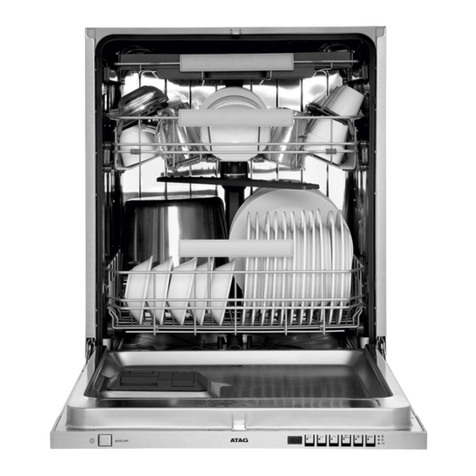
Atag
Atag VA63211VT/A01 User manual
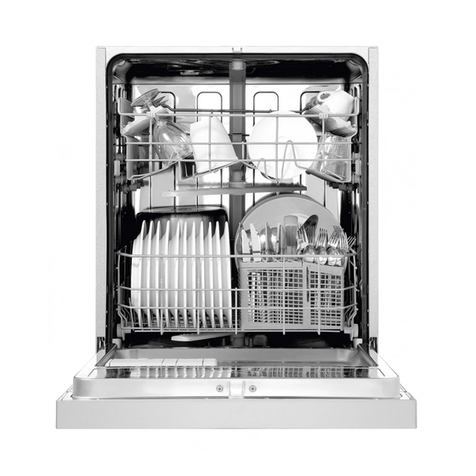
Atag
Atag VA6311NF User manual
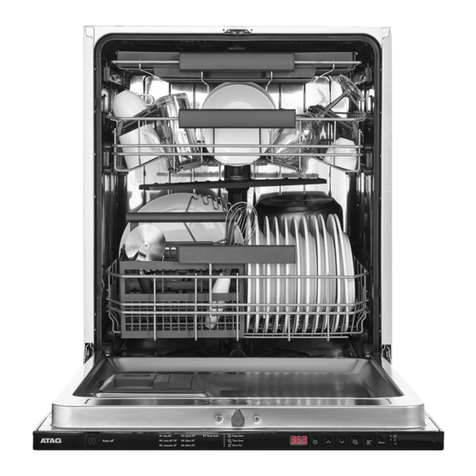
Atag
Atag VA63315OT User manual
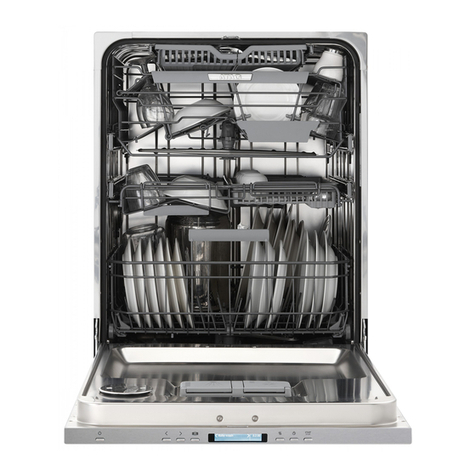
Atag
Atag VA8018TT User manual
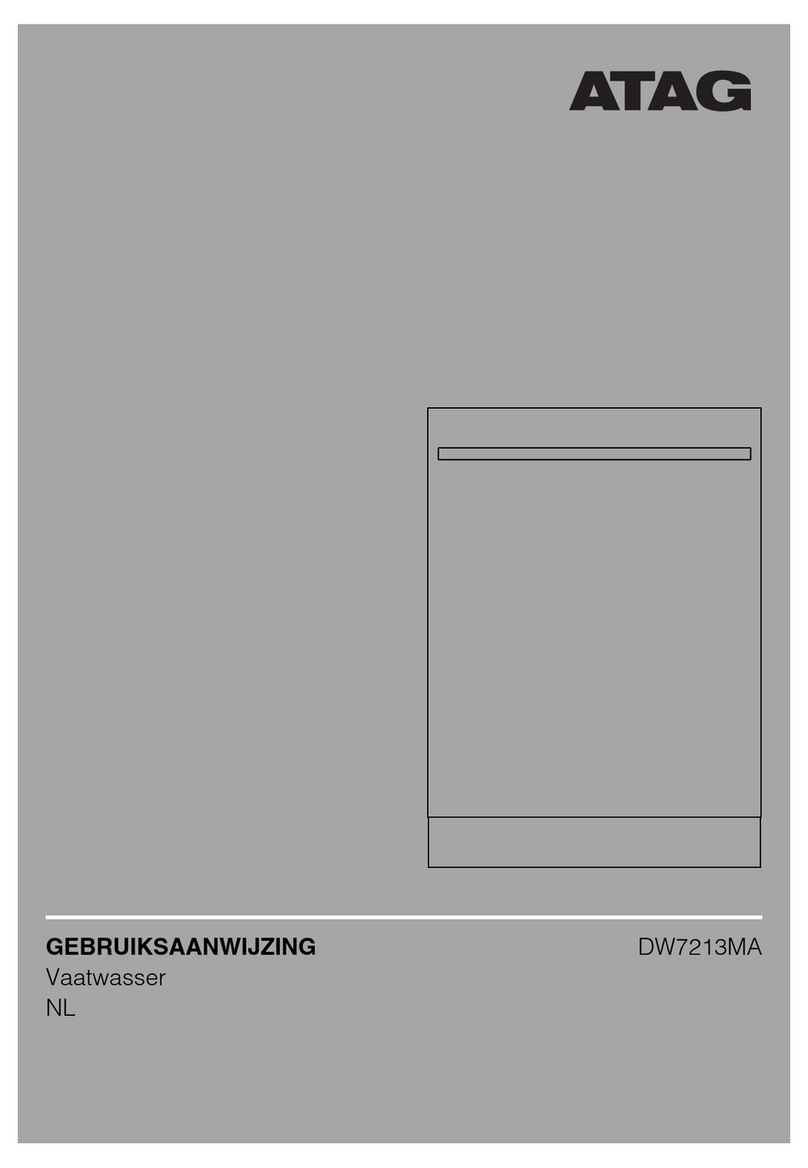
Atag
Atag DW7213MA User manual
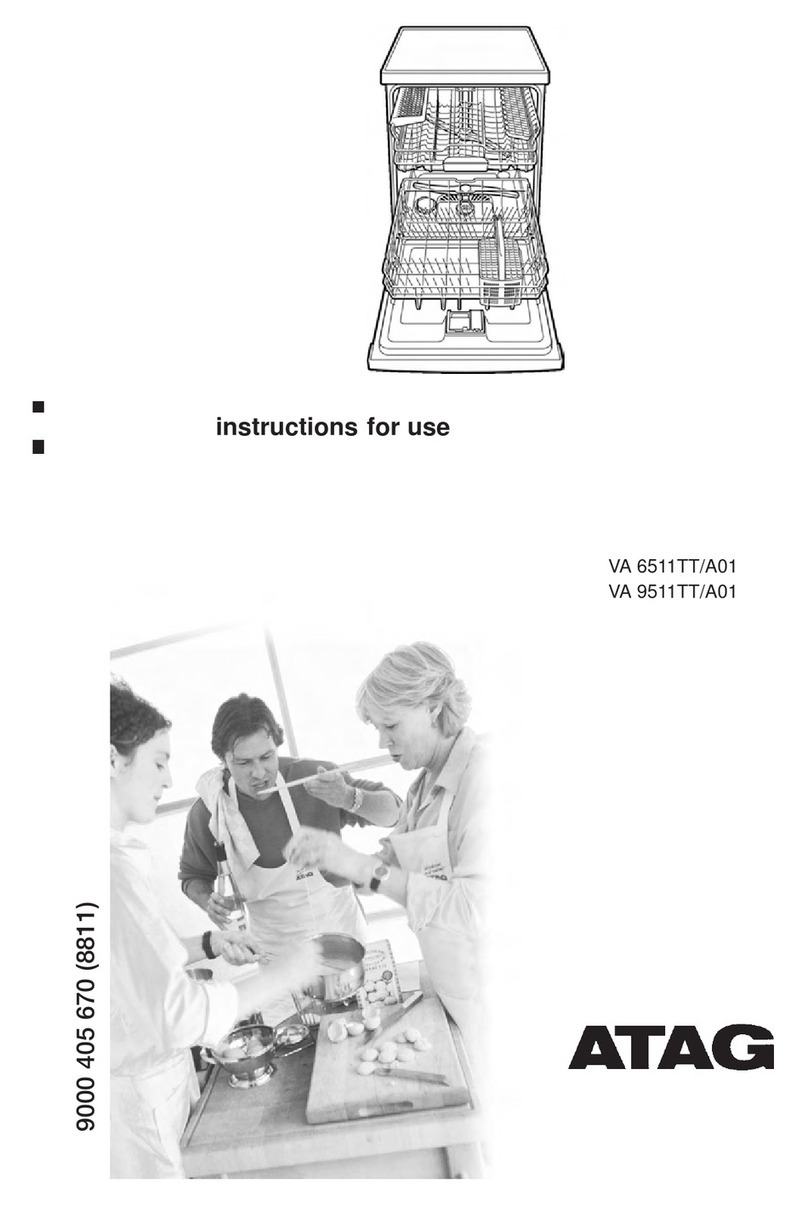
Atag
Atag VA 6511TT/A01 User manual
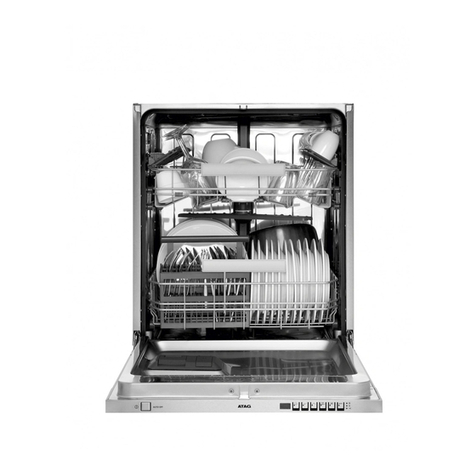
Atag
Atag VA63211ST/A01 User manual
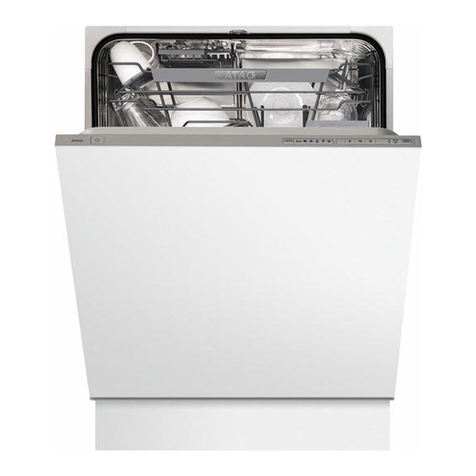
Atag
Atag VA9611QT User manual

Atag
Atag VA46309AT User manual

